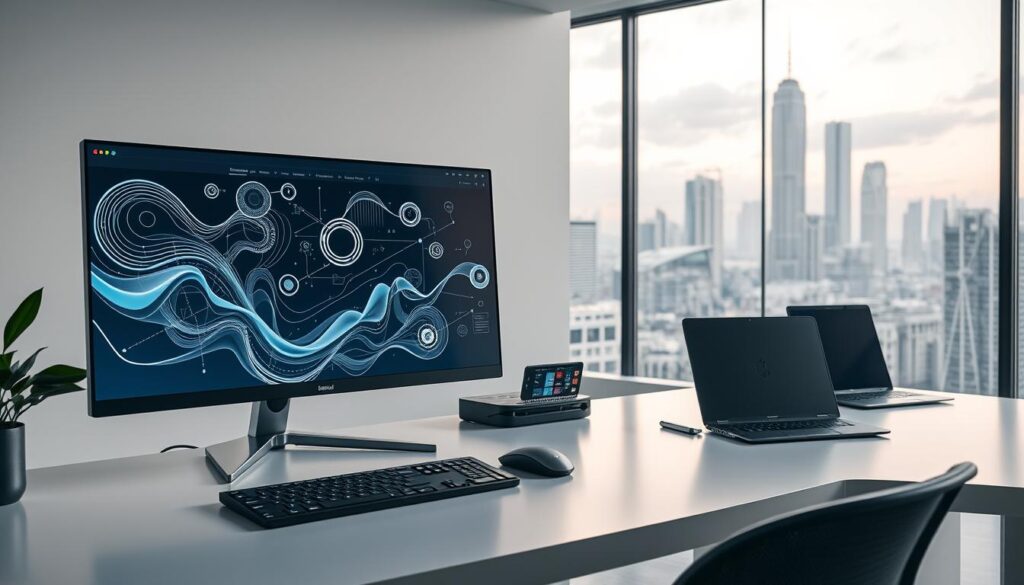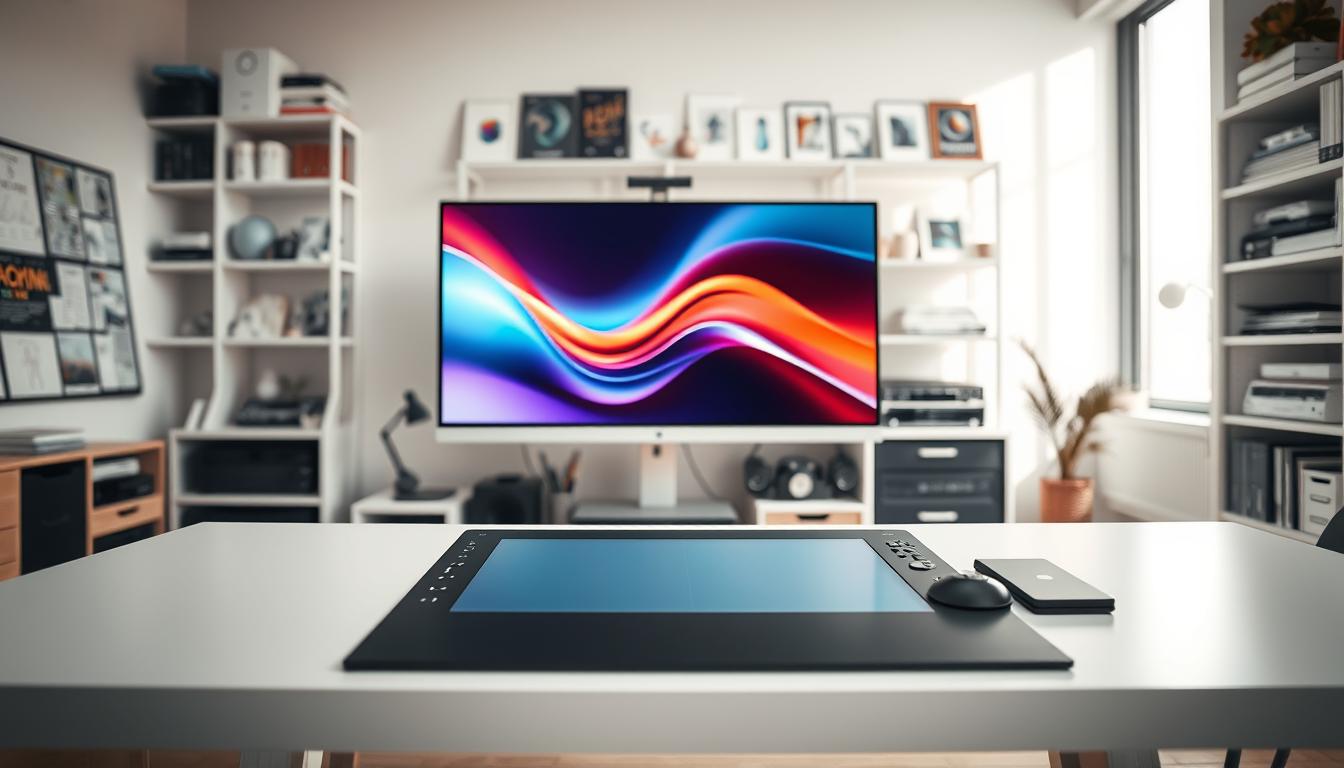In today’s fast-paced creative landscape, having the right online design platforms can make all the difference in producing high-quality work.
The rise of digital design tools has democratized access to professional-grade design capabilities, enabling creators to bring their visions to life with unprecedented ease and flexibility.
These innovative platforms offer a wide range of functionalities, from graphic and UI/UX design to video editing and animation, empowering artists and designers to push the boundaries of their creativity.
Key Takeaways
- Discover the most effective online design platforms for your creative needs.
- Learn how digital design tools can streamline your workflow.
- Explore the diverse range of functionalities offered by these platforms.
- Understand the impact of digital design tools on the creative industry.
- Identify the best tools to elevate your creations and stay ahead of the curve.
Understanding the Power of Modern Design Technology
Design technology has come a long way, empowering designers with unprecedented capabilities. The integration of graphic design software and ui/ux design software into the design process has marked a significant shift towards digital creativity.

How Digital Tools Transform the Creative Process
Digital tools have revolutionized the creative process by offering a wide range of functionalities that enhance productivity and innovation. With the ability to easily edit, manipulate, and experiment with different designs, designers can now achieve complex tasks with greater ease and precision. The use of graphic design software, for instance, allows for the creation of intricate graphics and visual elements that were previously challenging to produce.
Assessing Your Design Needs and Workflow
To maximize the benefits of modern design technology, it’s crucial to assess your design needs and workflow. This involves understanding the specific requirements of your projects and identifying the tools that best suit those needs. By integrating the right ui/ux design software into your workflow, you can streamline your design process, improve collaboration, and ultimately deliver more effective design solutions.
Essential Digital Design Tools for Graphic Creation
In the realm of graphic creation, the right digital tools can make all the difference. The ability to produce high-quality graphics efficiently is crucial for designers. This section will explore the essential digital design tools that are currently shaping the industry.
Mastering Raster-Based Software
Raster-based software is fundamental for graphic designers, offering the capability to edit and manipulate pixel-based images. Two prominent tools in this category are Adobe Photoshop and Procreate.
Adobe Photoshop: Advanced Techniques for Designers
Adobe Photoshop remains the industry standard for raster graphics editing. It offers a wide range of tools for photo manipulation, digital painting, and image editing. Advanced techniques in Photoshop include using layers, masking, and content-aware fill to achieve complex compositions.
Procreate: Digital Painting and Illustration
Procreate is a powerful digital painting and illustration tool that has gained popularity among designers and artists. Its intuitive interface and robust feature set make it ideal for creating high-quality, detailed artworks. Procreate’s brush engine and layer management capabilities allow for a seamless creative process.
Vector Graphics Tools for Precision Design
Vector graphics tools are indispensable for creating scalable graphics that maintain their quality across various dimensions. Adobe Illustrator and Affinity Designer are two leading software options in this domain.
Adobe Illustrator: Creating Scalable Graphics
Adobe Illustrator is the go-to software for creating vector graphics, logos, and icons. Its powerful vector tools enable designers to craft scalable graphics with precision. Advanced features include the use of the pen tool, shape building, and gradient manipulation.
Affinity Designer: Professional Alternative
Affinity Designer is a professional-grade vector graphics editor that offers a robust alternative to Adobe Illustrator. It boasts a user-friendly interface and advanced features like vector brushes and customizable workspaces, making it a favorite among professional designers.
Layout and Publishing Software
Layout and publishing software are critical for designers who work on print and digital publications. Adobe InDesign and Canva are two key players in this category.
Adobe InDesign: Print and Digital Publishing
Adobe InDesign is the industry standard for page design and layout. It is used for creating brochures, magazines, and e-books. Its advanced typography and layout tools enable designers to produce professional-grade publications.
Canva: User-Friendly Design for Everyone
Canva is a user-friendly graphic design platform that caters to both professionals and non-designers. It offers a range of templates and design tools that simplify the process of creating social media graphics, presentations, and posters.
Web and UI/UX Design Tools for Interactive Experiences
Web and UI/UX design tools have revolutionized the way we approach interactive experiences. These tools enable designers to craft engaging, user-friendly interfaces that captivate audiences across various digital platforms.
Prototyping and Wireframing Platforms
Prototyping and wireframing are crucial steps in the UI/UX design process, allowing designers to visualize and test their ideas before implementation.
Figma: Collaborative Design in Real-Time
Figma stands out as a powerful collaborative tool that enables real-time design interactions. Its cloud-based platform facilitates seamless feedback and iteration, making it a favorite among design teams.
Sketch: Mac-Based UI Design Solution
Sketch is a renowned UI design tool exclusive to Mac, offering a robust set of features tailored for user interface design. Its extensive plugin ecosystem further enhances its capabilities.
Adobe XD: Streamlined Experience Design
Adobe XD is a comprehensive tool for experience design, integrating wireframing, prototyping, and design within a single application. Its seamless integration with other Adobe tools makes it a versatile choice.
Code-Friendly Design Tools
Code-friendly design tools bridge the gap between design and development, enabling a smoother transition from concept to reality.
Webflow: Visual Development Environment
Webflow is a groundbreaking tool that allows designers to create responsive websites visually, without needing to write code. It empowers designers to control both the design and development aspects.
InVision Studio: Prototyping and Animation
InVision Studio is a powerful design tool that combines prototyping with advanced animation capabilities. It enables designers to craft complex interactions and animations with ease.
User Testing and Feedback Tools
User testing and feedback are vital for refining designs and ensuring they meet user needs.
Maze: User Testing for Designers
Maze is a user testing tool designed specifically for designers, allowing for quick and actionable insights into user behavior. It helps in validating design decisions.
Hotjar: Visual Feedback Analytics
Hotjar provides visual feedback analytics, offering insights into how users interact with websites. It helps designers understand user behavior and make data-driven decisions.
Specialized Digital Design Tools for Enhanced Workflow
Specialized digital design tools offer a range of benefits that can streamline your creative process. By incorporating these tools into your workflow, you can enhance productivity and achieve more refined design outcomes.
Digital Sketching and Concept Development
Digital sketching tools have revolutionized the initial stages of the design process. They allow for quick iteration and experimentation, making it easier to explore different concepts.
Concepts: Infinite Canvas for Ideas
Concepts offers an infinite canvas that is perfect for brainstorming and developing ideas without the constraints of a limited workspace. It’s ideal for creating rough sketches and iterating on designs.
Sketchbook: Natural Drawing Experience
Sketchbook provides a natural drawing experience with a variety of brushes and tools that mimic traditional drawing techniques. It’s designed to feel intuitive and comfortable for artists and designers.
Digital Asset Management Systems
Efficiently managing your digital assets is crucial for maintaining a streamlined workflow. Digital asset management systems help organize and retrieve files quickly.
Adobe Bridge: Organizing Creative Files
Adobe Bridge is a powerful tool for organizing and managing creative files. It allows for easy browsing, labeling, and filtering of assets, making it simpler to find the resources you need.
Bynder: Enterprise Asset Management
Bynder is an enterprise-level digital asset management system that offers advanced features for organizing, sharing, and collaborating on digital assets across teams and organizations.
Color and Typography Tools
Selecting the right colors and typography is critical for effective design. Specialized tools can help in creating harmonious color palettes and managing fonts.
Adobe Color: Creating Harmonious Palettes
Adobe Color is a tool that helps designers create and manage color palettes. It integrates well with other Adobe tools, making it easy to apply consistent color schemes across projects.
Fontbase: Font Management Made Simple
Fontbase is a font management tool that simplifies the process of organizing and accessing fonts. It’s particularly useful for designers working with a large number of fonts.
Conclusion: Creating Your Ideal Digital Design Toolkit
As we’ve explored the vast landscape of digital design tools, it’s clear that the right toolkit can elevate your creations and streamline your workflow. By understanding your specific design needs and assessing your workflow, you can make informed decisions about which digital design tools to incorporate.
From graphic creation and web design to UI/UX and specialized tasks, the ideal digital design toolkit is one that is tailored to your unique requirements. Whether you’re a seasoned designer or just starting out, leveraging the right digital design tools can help you achieve your creative vision.
By combining the essential tools for graphic creation, web and UI/UX design, and specialized tasks, you can create a comprehensive toolkit that enhances your productivity and fosters innovation. As the digital design landscape continues to evolve, staying up-to-date with the latest digital design tools will be crucial to staying ahead of the curve.
